Robert Adam
Robert Adam FRSE FRS FSA (Scot) FSA FRSA (3 July 1728 – 3 March 1792) was a Scottish neoclassical architect, interior designer and furniture designer. He was the son of William Adam (1689–1748), Scotland's foremost architect of the time, and trained under him. With his older brother John, Robert took on the family business, which included lucrative work for the Board of Ordnance, after William's death.
Robert Adam FRSE FRS FSA (Scot) FSA FRSA | |||||||||||
|---|---|---|---|---|---|---|---|---|---|---|---|
 Portrait attributed to George Willison, c. 1770–1775 | |||||||||||
| Born | 3 July 1728 | ||||||||||
| Died | 3 March 1792 (aged 63) | ||||||||||
| Burial place | Westminster Abbey | ||||||||||
| Nationality | Scottish | ||||||||||
| Alma mater | University of Edinburgh | ||||||||||
| Style | Neoclassical | ||||||||||
| Parent(s) |
| ||||||||||
| Relatives |
| ||||||||||
| |||||||||||
.jpg)
In 1754, he left for Rome, spending nearly five years on the continent studying architecture under Charles-Louis Clérisseau and Giovanni Battista Piranesi. On his return to Britain he established a practice in London, where he was joined by his younger brother James. Here he developed the "Adam Style", and his theory of "movement" in architecture, based on his studies of antiquity and became one of the most successful and fashionable architects in the country. Adam held the post of Architect of the King's Works from 1761 to 1769.
Robert Adam was a leader of the first phase of the classical revival in England and Scotland from around 1760 until his death.[2] He influenced the development of Western architecture, both in Europe and in North America. Adam designed interiors and fittings as well as houses.[3] Much of his work consisted of remodelling existing houses, as well as contributions to Edinburgh's townscape and designing romantic pseudo-mediaeval country houses in Scotland.[4]
He served as the member of Parliament for Kinross-shire from 1768 to 1774.[5]
Biography
Early life

Adam was born on 3 July 1728 at Gladney House in Kirkcaldy, Fife, the second son Mary Robertson (1699–1761), the daughter of William Robertson of Gladney, and architect William Adam.[1][6] As a child he was noted as having a "feeble constitution".[7] From 1734 at the age of six Adam attended the Royal High School, Edinburgh[8] where he learned Latin (from the second year lessons were conducted in Latin)[9] until he was 15, he was taught to read works by Virgil, Horace, Sallust and parts of Cicero and in his final year Livy.[9] In autumn 1743 he matriculated at the University of Edinburgh,[10] and compulsory classes for all students were: the Greek language, logic, metaphysics and natural philosophy.[10] Students could choose three elective subjects, Adam attended classes in mathematics, taught by Colin Maclaurin, and anatomy, taught by Alexander Monro primus.[11] His studies were interrupted by the arrival of Bonnie Prince Charlie and his Highlanders, who occupied Edinburgh during the 1745 Jacobite rising. At the end of the year, Robert fell seriously ill for some months, and it seems unlikely that he returned to university, having completed only two years of study.[12]
On his recovery from illness in 1746, he joined his elder brother John as apprentice to his father. He assisted William Adam on projects such as the building of Inveraray Castle and the continuing extensions of Hopetoun House. William's position as Master Mason to the Board of Ordnance also began to generate much work, as the Highlands were fortified following the failed Jacobite revolt. Robert's early ambition was to be an artist rather than architect, and the style of his early sketches in the manner of Salvator Rosa are reflected in his earliest surviving architectural drawings, which show picturesque gothic follies.[13] William Adam died in June 1748, and left Dowhill, a part of the Blair Adam estate which included a tower house, to Robert.
Architectural practice in Edinburgh
On William Adam's death, John Adam inherited both the family business and the position of Master Mason to the Board of Ordnance. He immediately took Robert into partnership, later to be joined by James Adam. The Adam Brothers' first major commission was the decoration of the grand state apartments on the first floor at Hopetoun House, followed by their first "new build" at Dumfries House. For the Board of Ordnance, the brothers were the main contractor at Fort George, a large modern fort near Inverness designed by military engineer Colonel Skinner. Visits to this project, begun in 1750, would occupy the brothers every summer for the next 10 years, and, along with works at many other barracks and forts, provided Robert with a solid foundation in practical building.[14]
In the winter of 1749–1750, Adam travelled to London with his friend, the poet John Home. He took the opportunity for architectural study, visiting Wilton, designed by Inigo Jones, and the Queens Hermitage in Richmond by Roger Morris. His sketchbook of the trip also shows a continuing interest in gothic architecture.[15]
Among his friends at Edinburgh were the philosophers Adam Ferguson and David Hume and the artist Paul Sandby whom he met in the Highlands. Other Edinburgh acquaintances included Gilbert Elliot, William Wilkie, John Home and Alexander Wedderburn.[13]
Grand Tour
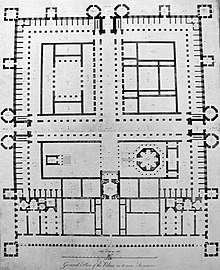
.jpg)
On 3 October 1754, Robert Adam in the company of his brother James (who went as far as Brussels) set off from Edinburgh for his Grand Tour, stopping for a few days in London, where they visited the Mansion House, London, St Stephen Walbrook,[16] St Paul's Cathedral, Windsor, Berkshire, in the company of Thomas Sandby who showed them his landscaping at Windsor Great Park and Virginia Water Lake.[17] They sailed from Dover arriving in Calais[18] on 28 October 1754.[19] He joined Charles Hope-Weir, brother of the Earl of Hopetoun in Brussels[20] and together they travelled to Rome.[21] Hope agreed to take Adam on the tour at the suggestion of his uncle, the Marquess of Annandale, who had undertaken the Grand Tour himself. While in Brussels the pair attended a Play and Masquerade, as well as visiting churches and palaces in the city.[22] Travelling on to Tournai, then Lille, where they visited the Citadal designed by Sébastien Le Prestre de Vauban.[23] By 12 November 1754 Adam and Hope were in Paris where they took lodgings in Hotel de Notre Dame.[24]
Adam and Hope travelled on to Italy together, before falling out in Rome over travelling expenses and accommodation. Robert Adam stayed on in Rome until 1757, studying classical architecture and honing his drawing skills. His tutors included the French architect and artist Charles-Louis Clérisseau, and the Italian artist Giovanni Battista Piranesi. Here, he became acquainted with the work of the pioneering classical archaeologist and art historian, theorist Johann Joachim Winckelmann. On his return journey, Adam and Clerisseau spent time intensively studying the ruins of Diocletian's Palace at Spalatro in Dalmatia (now known as Split, in modern Croatia).[25] These studies were later published as Ruins of the Palace of the Emperor Diocletian at Spalatro in Dalmatia in 1764.
Architectural practice in London

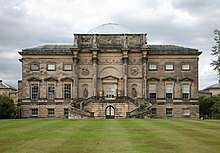
He returned to Britain in 1758 and set up in business in London with his brother James Adam. They focused on designing complete schemes for the decoration and furnishing of houses. Palladian design was popular, and Robert designed a number of country houses in this style,[26] but he evolved a new, more flexible style incorporating elements of classical Roman design alongside influences from Greek, Byzantine and Baroque styles.[27] The Adam brothers' success can also be attributed to a desire to design everything down to the smallest detail, ensuring a sense of unity in their design. In Adam interiors, all the furnishings were custom designed to accord with the decoration of the room in a unified harmony. Often the carpets were woven to match the intricate patterns of the ceiling above, while every fitting including sconces, mirrors, and doorknobs also received a custom design emulating the motifs of the room.[28][29]
Adams' practice was not without mishap, however. In 1768 the Adam brothers purchased a 99-year lease for a marshy plot of land beside the Thames in Westminster, where they built a 24-house terrace development known as the Adelphi.[28] The project was very ambitious and is the first instance where terraced houses were designed individually to give unified harmony to the whole development (previously terraced houses were built to one replicated design side-by-side, around a square).[28] However, the project became a white elephant for Robert and his brothers, with uncertain financing and costs spiralling out of control. The houses were built on a huge artificial terrace resting on vaulted substructures on the level of the Thames, which Robert Adam was certain could be leased to the British government as warehouses. However, this interest failed to materialize, and the Adam brothers were left with huge debts and in 1772 had to lay off 3,000 workmen and cease building. Adam himself moved into one of the houses in the Adelphi, along with supportive friends like David Garrick and Josiah Wedgewood, who opened a showroom for his ceramics in one of the houses. In 1774, a public lottery was held to raise funds for the brothers, which allowed them to avert bankruptcy.[28]
Public life

Adam was elected a fellow of the Society for the Encouragement of Arts, Manufactures and Commerce in 1758 and of the Society of Antiquaries in 1761, the same year he was appointed Architect of the King's Works (jointly with Sir William Chambers). His younger brother James succeeded him in this post when he relinquished the role in 1768 to devote more time to his elected office as member of Parliament for Kinross-shire.
Architectural style
Adam rejected the Palladian style, as introduced to England by Inigo Jones, and advocated by Lord Burlington, as "ponderous" and "disgustful".[30] However, he continued their tradition of drawing inspiration directly from classical antiquity, during his four-year stay in Europe.[30] Adam developed a new style of architectural decoration, one which was more archaeologically accurate than past Neoclassical styles, but nonetheless innovative and not bound only by ancient precedents. In Works in Architecture, co-authored with his brother James, the brothers stated that Graeco-Roman examples should "serve as models which we should imitate, and as standards by which we ought to judge."[28] The discoveries in Herculaneum and Pompeii ongoing at the time provided ample material for Robert Adam to draw on for inspiration.[28]
The Adam brothers' principle of "movement" was largely Robert's conception, although the theory was first written down by James. "Movement" relied on dramatic contrasts and diversity of form, and drew on the picturesque aesthetic. The first volume of the Adam brother's Works (1773) cited Kedleston Hall, designed by Robert in 1761, as an outstanding example of movement in architecture.
By contrasting room sizes and decorative schemes, Adam applied the concept of movement to his interiors also. His style of decoration, described by Pevsner as "Classical Rococo", drew on Roman "grotesque" stucco decoration.[30][31]
Influence
Adam's work had influenced the direction of architecture and design across the western world. In England his collaboration with Thomas Chippendale resulted in some of the finest neoclassicist designs of the time, most notably in the Harewood House collection of Chippendale's work. In North America, the Federal style owes much to neoclassicism as practised by Adam. In Europe, Adam notably influenced Charles Cameron, the Scotsman who designed Tsarskoye Selo and other Russian palaces for Catherine the Great.[32] However, by the time of his death, Adam's neoclassicism was being superseded in Britain by a more severe, Greek phase of the classical revival, as practised by James "Athenian" Stuart. The Adam brothers employed several draughtsmen who would go on to establish themselves as architects, including George Richardson, and the Italian Joseph Bonomi, who Robert originally hired in Rome.
Written works
During their lifetime Robert and James Adam published two volumes of their designs, Works in Architecture of Robert and James Adam (in 1773–1778 and 1779; a third volume was published posthumously, in 1822).
Death and burial
Adam had long suffered from stomach and bowel problems,[33] probably caused by a peptic ulcer and irritable bowel syndrome. While at home – 11 Albermarle Street, London – on 1 March 1792, one of the ulcers burst, and on 3 March Adam died.[33]
The funeral was held on 10 March; he was buried in the south aisle of Westminster Abbey.[33] The pall-bearers were several of his clients: Henry Scott, 3rd Duke of Buccleuch; George Coventry, 6th Earl of Coventry; James Maitland, 8th Earl of Lauderdale; David Murray, 2nd Earl of Mansfield; Lord Frederick Campbell and Sir William Pulteney, 5th Baronet.[33]
Knowing he was dying, he drafted his will on 2 March 1792. Having never married, Adam left his estate to his sisters Elizabeth Adam and Margaret Adam.[33]
His obituary appeared in the March 1792 edition of The Gentleman's Magazine:[34]
It is somewhat remarkable that the Arts should be deprived at the same time of two of their greatest ornaments, Sir Joshua Reynolds and Mr Adam: and it is difficult to say which of them excelled most in his particular profession... Mr Adam produced a total change in the architecture of this country: and his fertile genius in elegant ornament was not confined to the decoration of buildings, but has been diffused to every branch of manufacture. His talents extend beyond the lie of his own profession: he displayed in his numerous drawings in landscape a luxuriance of composition, and an effect of light and shadow, which have scarcely been equalled...to the last period of his life, Mr Adam displayed an increasing vigour of genius and refinement of taste: for in the space of one year preceding his death, he designed eight great public works, besides twenty five private buildings, so various in their style, and so beautiful in their composition, that they have been allowed by the best judges, sufficient of themselves, to establish his fame unrivalled as an artist.
He left nearly 9,000 drawings, 8,856 of which (by both Robert and James Adam) were subsequently purchased in 1833 for £200 by the architect John Soane and are now at the Soane Museum in London.[35]
List of architectural works[36]
Public buildings
- Fort George, Scotland, the buildings within the fort were designed by William Adam, after his death his sons oversaw completion (1748–69)
- The Argyll Arms, Inveraray (1750–56)
- The Town House, Inveraray (1750–57)
- Royal Exchange, Edinburgh, with his brother John Adam (1753–54)
- Screen in front of the Old Admiralty, Whitehall, London (1760)
- Kedleston Hotel, Quarndon (1760)
- Little Market Hall, High Wycombe, Buckinghamshire (1761) later altered
- Riding School, Edinburgh (1763) demolished
- Courts of Justice and Corn Market, Hertford, Hertfordshire, now Shire Hall (1768). Altered, but partially restored to original design. A joint project with James Adam.
- Pulteney Bridge, Bath (1770)
- County House, Kinross (1771)
- Royal Society for the encouragement of Arts, Manufactures & Commerce (1772)
- Register House, Edinburgh (1774–1789)
- The Market Cross, Bury St Edmunds, refaced and upper floor added (a theatre now art gallery) (1776)
- Theatre Royal, Drury Lane, London, remodelled, (1775) demolished
- Red Lion Inn, Pontefract (1776)
- Drummonds Bank, Charing Cross, London (1777–78) demolished
- Home House, London (1777)
- Old College, University of Edinburgh, (1788-onwards) completed to an amended design by William Henry Playfair 1831
- The Bridewell, Edinburgh, (1791) demolished
- The Assembly Rooms, Glasgow (1791–94) demolished
- Trades Hall, Glasgow, Scotland (1791–1792) (completed 1792–1802 by his brothers)
- The Royal Infirmary, Glasgow (1791–94) rebuilt 1914
- Coutts Bank enclosed bridge, John Adam Street (1799) later demolished
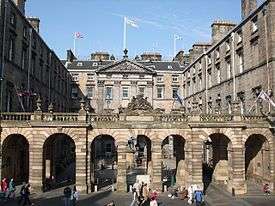 The City Chambers, Edinburgh
The City Chambers, Edinburgh Register House, Edinburgh
Register House, Edinburgh Register House, cross section, Edinburgh
Register House, cross section, Edinburgh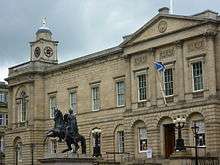 Register House, Edinburgh
Register House, Edinburgh- Old College Edinburgh, Dome added later
 The Market Cross, Bury St Edmunds
The Market Cross, Bury St Edmunds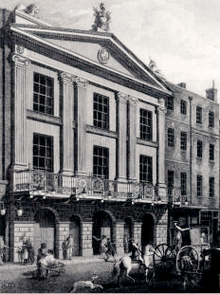 Theatre Royal Drury Lane, London, rebuilt
Theatre Royal Drury Lane, London, rebuilt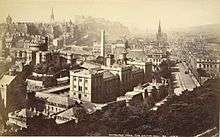 Edinburgh Bridewell in foreground, demolished
Edinburgh Bridewell in foreground, demolished Pulteney Bridge, Bath
Pulteney Bridge, Bath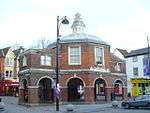 Little Market Hall, High Wycombe
Little Market Hall, High Wycombe McLennan Arch, Glasgow, built from the remains of Glasgow Assembly Rooms
McLennan Arch, Glasgow, built from the remains of Glasgow Assembly Rooms Kedleston Hotel, Quarndon
Kedleston Hotel, Quarndon Coutts Bank, John Adam Street, demolished and replaced with this building
Coutts Bank, John Adam Street, demolished and replaced with this building.jpg) Register House Edinburgh, interior of the dome
Register House Edinburgh, interior of the dome
Churches
- Yester Chapel, Lothian, new west front in Gothic style (1753)
- Cumnock church, Ayrshire (1753–54) demolished
- St. Mary Magdalene, Croome Park, interior (1761–63) the church was designed by Lancelot "Capability" Brown
- St. Andrew's Church, Gunton Hall, Gunton, Norfolk (1769)
- St Mary's, Mistley (1776) only the towers survive
- St. George's Chapel, Edinburgh, (1792) demolished
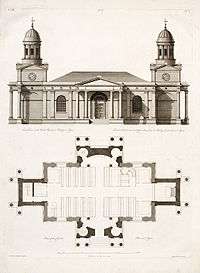 Mistley Church as built
Mistley Church as built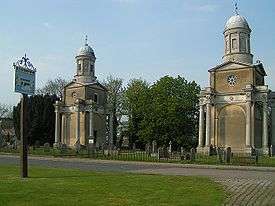 Mistley Church as it survives
Mistley Church as it survives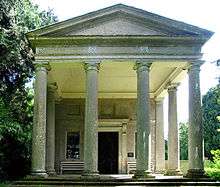 St. Andrew's Church Gunton
St. Andrew's Church Gunton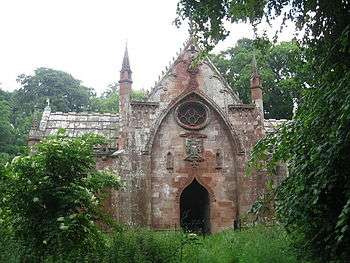 Yester Chapel, west front
Yester Chapel, west front
Mausoleums
- William Adam Mausoleum, Greyfriars Kirkyard (1753–55)
- Bowood House Mausoleum (1761–64)
- David Hume Mausoleum, Old Calton Cemetery (1777–78)
- Templetown Mausoleum, Castle Upton, County Antrim Ireland (1789) for 2nd Lord Templetown.
- Johnstone Family Mausoleum, Ochil Road graveyard, Alva, Clackmannanshire (1789–90)
- Johnstone Family Mausoleum, Westerkirk graveyard, near Bentpath, Dumfries and Galloway 1790
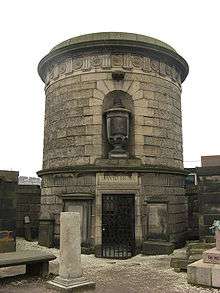 David Hume Mausoleum
David Hume Mausoleum Templetown Mausoleum
Templetown Mausoleum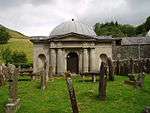 Johnstone Family Mausoleum, Bentpath
Johnstone Family Mausoleum, Bentpath
Urban domestic work
- Little Wallingford House, Whitehall, London, alterations (1761) demolished
- Lansdowne House, Berkeley Square, London (1762–67), partially demolished, the Dining Room is in the Metropolitan Museum of Art and the Drawing Room is in Philadelphia Museum of Art
- 34 Pall Mall, London (1765–66) demolished
- Langford House, Mary Street, Dublin, Ireland. (1765) Remodelling of house for Rt. Hon. Hercules Langford Rowley. Demolished 1931.
- 16 Hanover Square, London, alterations (1766–67) demolished
- Deputy Ranger's lodge, Green Park, London (1768–71) demolished in the 19th century
- The Adelphi development, London (1768–1775) mostly demolished 1930s, a ceiling & fireplace are in the Victoria and Albert Museum
- Chandos House, London (1770–71)
- 8 Queen Street, Edinburgh (1770–71) originally designed for Lord Chief Baron Ord, now housing the Royal College of Physicians of Edinburgh[37]
- Mansfield Street, London (1770–72)
- Northumberland House, London, alterations (1770) demolished, parts of the Glass Drawing Room survive in the Victoria and Albert Museum
- 20 St. James's Square (1771–74)
- 33 St. James's Square (1771–73)
- Ashburnham House, Dover Street, London, alterations (1773)
- Derby House, 26 Grosvenor Square (1773–74) demolished
- Portland Place, London (1773–94) (only a few houses survive)
- 11 St. James's Square (1774–76)
- Frederick's Place, London (1775–78)
- Roxburghe House, Hanover Square, London (1776–78) demolished
- Home House, London (1777-before 1784)
- 31 (now 17) Hill Street, London alterations (1777–79)
- Apsley House, London (1778) altered
- Cumberland House, Pall Mall, London, alterations and interiors (1780–88) demolished
- Marlborough House, Brighton (1786)
- Fitzroy Square, London (1790–94) only the south and east sides were built
- Charlotte Square (north side), Edinburgh (1791–94)
- 169–185 High Street, Glasgow (1793) demolished
- 1–3 Robert Street
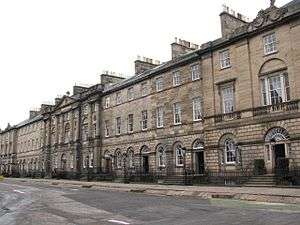 North side, Charlotte Square, Edinburgh
North side, Charlotte Square, Edinburgh Centre of North side, Charlotte Square, Edinburgh
Centre of North side, Charlotte Square, Edinburgh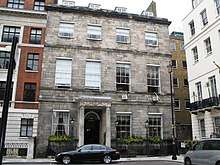 Chandos House London
Chandos House London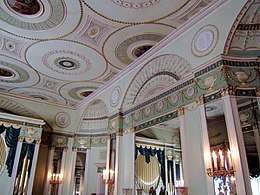 Music Room, Home House, London
Music Room, Home House, London Drawing Room, Home House, London
Drawing Room, Home House, London Design for the Etruscan Room, Home House, London
Design for the Etruscan Room, Home House, London Detail of the Etruscan Room, Home House, London
Detail of the Etruscan Room, Home House, London Staircase, Home House, London
Staircase, Home House, London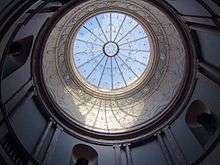 Staircase Dome, Home House, London
Staircase Dome, Home House, London South side, Fitzroy Square, London
South side, Fitzroy Square, London East side, Fitzroy Square, London
East side, Fitzroy Square, London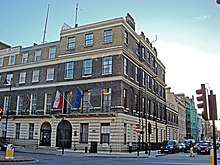 Surviving Adam Houses, Portland Place, London
Surviving Adam Houses, Portland Place, London The Adelphi, London, largely demolished
The Adelphi, London, largely demolished Robert Adam ceiling from the Adelphi, now in the V&A
Robert Adam ceiling from the Adelphi, now in the V&A Model of the Glass Drawing Room Northumberland House, in the V&A
Model of the Glass Drawing Room Northumberland House, in the V&A Panels from the Glass Drawing Room Northumberland House, in the V&A
Panels from the Glass Drawing Room Northumberland House, in the V&A Design for fireplaces in the withdrawing room and the Countess of Derby's dressing room, Derby House
Design for fireplaces in the withdrawing room and the Countess of Derby's dressing room, Derby House Drawing Room, Derby House
Drawing Room, Derby House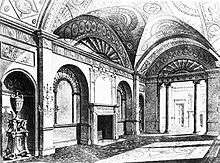 Drawing Room, Derby House
Drawing Room, Derby House Plan, Derby House
Plan, Derby House Ceiling, Countess of Derby's Dressing Room, Derby House
Ceiling, Countess of Derby's Dressing Room, Derby House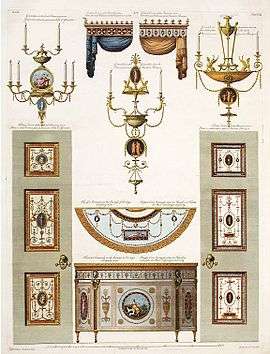 Details for Derby House in Grosvenor Square, an example of the Adam Brothers' decorative designs
Details for Derby House in Grosvenor Square, an example of the Adam Brothers' decorative designs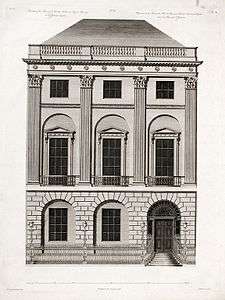 20 St. James's Square, London, front facade
20 St. James's Square, London, front facade 20 St. James's Square, London, rear facade
20 St. James's Square, London, rear facade Dining Room ceiling, 20 St. James's Square, London
Dining Room ceiling, 20 St. James's Square, London Music Room ceiling, 20 St. James's Square, London
Music Room ceiling, 20 St. James's Square, London Drawing Room ceiling, 20 St. James's Square, London
Drawing Room ceiling, 20 St. James's Square, London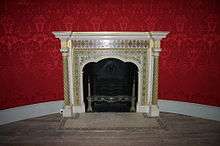 Fireplace, Round room, Strawberry Hill House, Middlesex
Fireplace, Round room, Strawberry Hill House, Middlesex 1-3 Robert Street
1-3 Robert Street- Lansdowne House Drawing Room, now in Philadelphia Art Museum
 Lansdown House dining room, now in the Metropolitan Museum of Art, New York
Lansdown House dining room, now in the Metropolitan Museum of Art, New York
Country houses with major work
- Dumfries House, Ayrshire (1754–1759)
- Paxton House, near Berwick-upon-Tweed (1758)
- Shardeloes, Amersham, Buckinghamshire (altered and completed the original design by Stiff Leadbetter) (1759–63)
- Harewood House, West Yorkshire (1759–1771)
- Kedleston Hall, near Derby (1759–1765)
- Mellerstain House, Kelso, Scottish Borders (1760–1768)
- Osterley Park, west London (1761–1780)
- Mersham le Hatch, Mersham, Ashford, Kent (1762–1766)
- Syon House interior, Brentford (1762–1769)
- Luton Hoo, Bedfordshire (1766–1770) later extensively reconstructed 1816 by Robert Smirke and other architects later
- Nostell Priory (1766–80)
- Newby Hall, Newby Boroughbridge, North Yorkshire (1767–76)
- Kenwood House, Hampstead, London (1768)
- Saltram House, Plymouth, Devon (1768–69)
- Bowood House, near Calne, Wiltshire, Diocletian wing, and other interiors (1770)
- Wedderburn Castle, Duns, Scottish Borders, Berwickshire (1770–1778)
- Culzean Castle, South Ayrshire (1772–1790)
- Moreton Hall, Suffolk (1773–1776), building and interiors
- Stowe, Buckinghamshire (1774)
- Moreton Hall, Bury St Edmund (1783)
- Brasted Place, Kent (c. 1783)
- Pitfour Castle, Tayside, attributed (c. 1785–90)
- Seton Castle, East Lothian (1789)
- Newliston, Lothian (1789)
- Dalquharran Castle, South Ayrshire (1789–1792); now a ruin
- Airthrey Castle, Stirlingshire (1790–1791)
- Balbardie House, Lothian (1792); demolished
- Gosford House, near Longniddry, East Lothian (1790–1800)
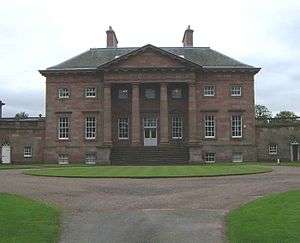 Paxton House, Berwickshire
Paxton House, Berwickshire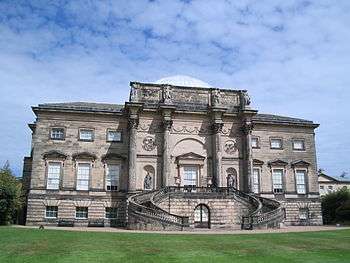 South front, Kedleston Hall
South front, Kedleston Hall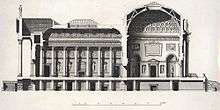 Cross section, Kedleston Hall
Cross section, Kedleston Hall Kedleston Hall, Marble Hall
Kedleston Hall, Marble Hall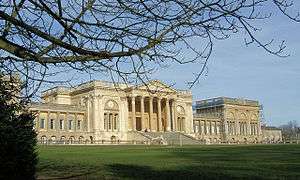 South front, Stowe House, slightly modified in execution
South front, Stowe House, slightly modified in execution Cross section of Hall, Syon House, London
Cross section of Hall, Syon House, London Plan, Syon House, London
Plan, Syon House, London Apse, Entrance Hall, Syon House
Apse, Entrance Hall, Syon House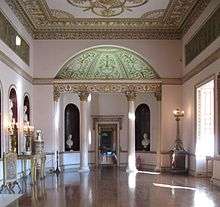 The Dining Room, Syon House
The Dining Room, Syon House The Ante-Room, Syon House
The Ante-Room, Syon House.jpg) The ceiling, Ante-Room, Syon House
The ceiling, Ante-Room, Syon House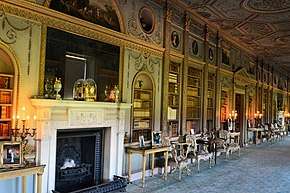 Long Gallery, Syon House
Long Gallery, Syon House Closet off Long Gallery, Syon House
Closet off Long Gallery, Syon House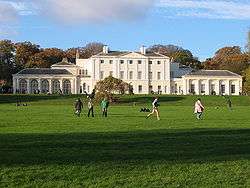 Kenwood House, London
Kenwood House, London Entrance portico, Kenwood House, London
Entrance portico, Kenwood House, London Kenwood House, Library
Kenwood House, Library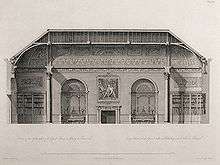 Cross section of the library, Kenwood House, London
Cross section of the library, Kenwood House, London The library ceiling, Kenwood House, London
The library ceiling, Kenwood House, London Nostell Priory, Yorkshire, Adam wing on right
Nostell Priory, Yorkshire, Adam wing on right Culzean Castle, Ayrshire
Culzean Castle, Ayrshire Culzean Castle, Ayrshire
Culzean Castle, Ayrshire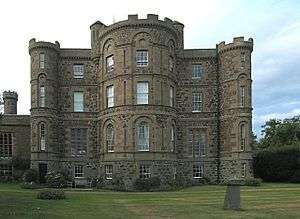 Pitfour Castle, Tayside
Pitfour Castle, Tayside.jpg) The Saloon, Saltram House
The Saloon, Saltram House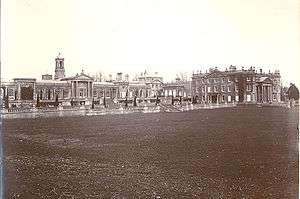 Bowood House, Adam's Diocletian wing on left, the main block demolished in 1950s
Bowood House, Adam's Diocletian wing on left, the main block demolished in 1950s Bowood House, Diocletian wing
Bowood House, Diocletian wing Wedderburn Castle, Berwickshire
Wedderburn Castle, Berwickshire The Entrance Hall Ceiling, Harewood House
The Entrance Hall Ceiling, Harewood House Harewood House, Yorkshire, altered by Sir Charles Barry
Harewood House, Yorkshire, altered by Sir Charles Barry Harewood House, State Bedroom
Harewood House, State Bedroom The Ceiling, State Bedroom, Harewood House
The Ceiling, State Bedroom, Harewood House Harewood House, Old Library
Harewood House, Old Library Harewood House, Music Room Ceiling
Harewood House, Music Room Ceiling The Music Room, Harewood House
The Music Room, Harewood House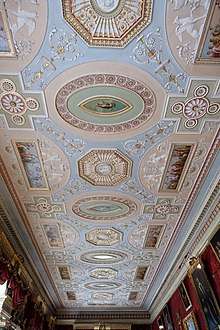 Gallery ceiling, Harewood House
Gallery ceiling, Harewood House The Gallery, Harewood House
The Gallery, Harewood House Gallery fireplace, Harewood House
Gallery fireplace, Harewood House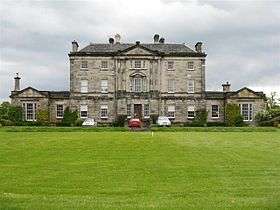 Newliston House
Newliston House Dalquarran Castle, Ayrshire
Dalquarran Castle, Ayrshire Luton Hoo House, Bedfordshire, altered by Sir Robert Smirke and again in the late 19th century
Luton Hoo House, Bedfordshire, altered by Sir Robert Smirke and again in the late 19th century Mellerstain House, Berwickshire
Mellerstain House, Berwickshire Osterley Park, London
Osterley Park, London Main Staircase, Osterley Park, London
Main Staircase, Osterley Park, London Entrance Hall, Osterley Park, London
Entrance Hall, Osterley Park, London Osterley Park, Drawing Room Ceiling
Osterley Park, Drawing Room Ceiling Portico Ceiling, Osterley Park
Portico Ceiling, Osterley Park
Garden buildings and follies
- Stables, Inveraray Castle, joint work with his brother John (1758–60)
- North Lodge, Kedleston Hall (1759)
- Conservatory Croome Park (1760)
- Rotunda Croome Park, attributed (1760)
- Old Rectory, Kedleston Hall (c. 1761)
- Entrance screen, Moor Park, Hertfordshire (1763)
- The Conservatory, Osterley Park (1763)
- Bridge, Audley End House, Essex (c. 1763–64)
- Tea Pavilion, Moor Park, Hertfordshire (c. 1764)
- Gatehouse Kimbolton Castle (c. 1764)
- Bridge, Kedleston Hall (1764)
- Estate Village Lowther, Cumbria (1766)
- Dunstall 'Castle' and Garden Alcove, Croome Park (1766)
- Entrance arch, Croome Court (1767)
- Entrance Screen, Cullen House, Cullen, Moray (1767)
- Bridge, Osterley Park (c. 1768)
- Entrance screen, Syon House (1769)
- Fishing, Boat & Bath House, Kedleston Hall (1770–71)
- Circular Temple, Audley End House, Essex (1771)
- Lion Bridge, Alnwick (1773)
- Stag Lodge, Saltram House, Devon (c. 1773)
- The Stables, Featherstone entrance & Huntwick arch Nostell Priory (1776)
- Wyke Green Lodges, Osterley, Middlesex (1777); remodelled
- the Home Farm, Culzean Castle, Ayrshire (1777–79)
- Brizlee Tower, Alnwick, Gothic tower (1777–81)
- Oswald's Temple, Auchincruive, Ayrshire (1778)
- 'Ruined' arch and viaduct, Culzean Castle (1780)
- The semi-circular conservatory, Osterley Park (1780)
- Tea House Bridge, Audley End House, Essex (1782)
- The Stables, Culzean Castle (c. 1785)
- Stables, Castle Upton, Templepatrick, Co. Antrim, Ireland. (1788–89). Important range of office buildings in castle style.
- Montagu Bridge, Dalkeith Palace, Lothian (1792)
- Loftus Hall, Fethard-on-sea, Co. Wexford, Ireland. Date unknown. Proposed gates.
- Lion Gate and Lodge, Syon Park, London. Date unknown.
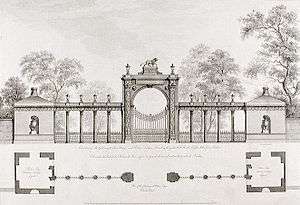 Screen, Syon House, London
Screen, Syon House, London The Lion Gate, Syon Park, London
The Lion Gate, Syon Park, London Gatehouse, Kimbolton Castle
Gatehouse, Kimbolton Castle Entrance Arch, Croome Park, Worcestershire
Entrance Arch, Croome Park, Worcestershire Garden Alcove, Croome Court, Worcestershire
Garden Alcove, Croome Court, Worcestershire Rotunda, Croome Park, Worcestershire
Rotunda, Croome Park, Worcestershire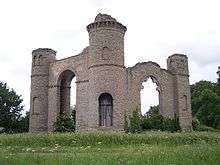 Dunstall "Castle", Croome Court, Worcestershire
Dunstall "Castle", Croome Court, Worcestershire Brizlee Tower, Alnwick
Brizlee Tower, Alnwick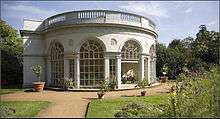 The semi-circular conservatory, Osterley Park
The semi-circular conservatory, Osterley Park Featherstone entrance, Nostell Priory, Yorkshire
Featherstone entrance, Nostell Priory, Yorkshire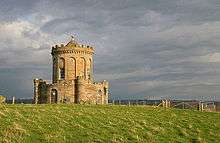 Oswald's Temple, Auchincruive, Ayrshire
Oswald's Temple, Auchincruive, Ayrshire- Kedleston Fishing, Bathing & Boat House
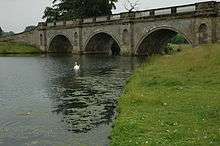 Kedleston Bridge
Kedleston Bridge Former Home Farm, Culzean Castle
Former Home Farm, Culzean Castle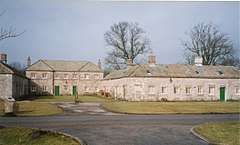 Lowther Castle Model Village
Lowther Castle Model Village Montagu Bridge, Dalkeith Palace
Montagu Bridge, Dalkeith Palace The Lion Bridge, Alnwick
The Lion Bridge, Alnwick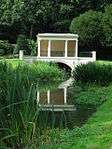 Tea House Bridge, Audley End
Tea House Bridge, Audley End Clock Tower, Stables, Castle Upton, Co. Meath
Clock Tower, Stables, Castle Upton, Co. Meath Stables, Culzean Castle, Ayrshire
Stables, Culzean Castle, Ayrshire
Country houses with minor work
- Hopetoun House, West Lothian (interiors) (1750–54), the house was designed by William Adam
- Ballochmyle House, Ayrshire (c. 1757–60)
- Compton Verney House, added the wings and interiors (1760–63)
- Croome Park, three interiors: the Library the fittings are in the Victoria and Albert Museum, Gallery and Tapestry Room this is now in the Metropolitan Museum of Art, (1760–65)
- Audley End House, redecoration of ground floor rooms (1763–65)
- Goldsborough Hall, near Knaresborough, North Yorkshire (1764–1765)
- Alnwick Castle, Northumberland (interiors) (1766) destroyed when Anthony Salvin created the current state rooms
- Woolton Hall, Woolton, Merseyside (1772), remodelled main façade and the interior
- Headfort House, County Meath, Ireland. Internal work, including stairs and notably the Great Eating Room (1775) for Thomas Taylour, 1st. Earl Bective.
- Wormleybury, Hertfordshire, internal work including entrance hall & staircase (1777)
- Downhill, near Coleraine, County Londonderry, Ireland. (1780) Design for dining room. Not executed. House is now a crumbling ruin.
- Moccas Court, Moccas, Herefordshire, internal work including drawing room (1781)
- Castle Upton, Templepartick, Co. Antrim, Ireland. Remodelling of house. (1782–83) for 1st. Lord Templetown.
- Archerfield House, Lothian, internal work including library (1791)
- Summerhill House, Co. Meath, Ireland. Date unknown. Proposed alterations. House now demolished.
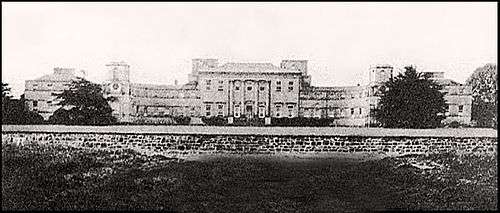 Summerhill House, Main Front.
Summerhill House, Main Front. Compton Verney House, wings by Adam
Compton Verney House, wings by Adam
Official appointments
| Parliament of Great Britain | ||
|---|---|---|
| Preceded by Robert Colvile (to 1761) |
Member of Parliament for Kinross-shire 1768–1774 |
Succeeded by George Graham (from 1780) |
| Government offices | ||
| Preceded by New appointment |
Architect of the King's Works 1761–1769 Served alongside: Sir William Chambers |
Succeeded by Sir Robert Taylor and James Adam |
See also
- Adam style
- Category:Robert Adam buildings
References
- James, Jude (2005). Kirkcaldy: A History & Celebration of the Town. p. 60. ISBN 1-84567-749-8.
- Pevsner, p. 237
- Adam silver (1953). Victoria & Albert Museum, London. Her Majesty's Stationery Office (HMSO), p. 1.
- Norwich, John Julius (1990). Oxford Illustrated Encyclopedia Of The Arts. USA: Oxford University Press. pp. 3. ISBN 978-0198691372.
- Waterston, Charles D; Macmillan Shearer, A (July 2006). Former Fellows of the Royal Society of Edinburgh 1783–2002: Biographical Index (PDF). I. Edinburgh: The Royal Society of Edinburgh. ISBN 978-0-902198-84-5. Retrieved 28 December 2011.
- Adam, Robert (1728–1792), architect. Oxford Dictionary of National Biography. Oxford University Press. doi:10.1093/ref:odnb/105.
- Fleming, p. 76
- Graham, p. 2
- Graham, p. 4
- Graham, p. 26
- Graham, p. 27
- Fleming, pp. 79–80
- Fleming, p. 81
- Fleming, pp. 85–86
- Fleming, p. 85
- Graham, p. 47
- Graham, p. 48
- Graham, p. 50
- Graham, p. 52
- Graham, p. 54
- Graham, p. 49
- Graham, p. 53
- Graham, p. 53-54
- Graham, p. 55
- C.M. Hogan, "Diocletian's Palace", The Megalithic Portal, A. Burnham ed, 6 Oct 2007
- Roth, p. 397
- Roth, p. 402
- Steven Parissien (1992). Adam Style. Phaidon. p. 43–44.
- David Irwin (1997). Neoclassicism. Phaidon. p. 101.
- Glendinning and McKechnie, p. 106
- Pevsner, p. 238
- Glendinning & McKechnie, p. 108
- Graham, Roderick (2009) Arbiter of Elegance: A Biography of Robert Adam, Birlinn, ISBN 978-1-84158-802-5, pp. 328–329
- Graham, p. 330
- page 11, The Adam Brothers in Rome: Drawings from the Grand Tour, A.A. Tait, 2008 Scala Publishers Ltd, ISBN 978-1-85759-574-1
- This list is based on: David King, The Complete Works of Robert & James Adam, 1991 Butterworth
- Craig, W. S. (1976). History of the Royal College of Physicians of Edinburgh. Oxford: Blackwell. pp. 73–74.
Sources
- Adam, Robert (1764) Ruins of the palace of the Emperor Diocletian at Spalatro in Dalmatia
- Bolton, Arthur T. (1922, reprinted 1984) The Architecture of Robert & James Adam, 1785–1794, 2 volumes ISBN 0-907462-49-9
- Curl, James Stevens (2006) Oxford Dictionary of Architecture and Landscape Architecture 2nd Edition. Oxford University Press. ISBN 0-19-860678-8
- Fleming, John (1962) Robert Adam and his Circle John Murray ISBN 0-7195-0000-1
- Glendinning, Miles, and McKechnie, Aonghus, (2004) Scottish Architecture, Thames and Hudson. ISBN 0-500-20374-1
- Graham, Roderick (2009) Arbiter of Elegance: A Biography of Robert Adam (Birlinn, ISBN 978-1-84158-802-5)
- Harris, Eileen (1963) The Furniture of Robert Adam Alec Tiranti, London. ISBN 0-85458-929-5.
- Harris, Eileen (2001) The Genius of Robert Adam: His Interiors ISBN 0-300-08129-4
- Lees-Milne, James (1947) The Age of Adam
- Pevsner, Nikolaus (1951) An Outline of European Architecture 2nd Edition. Pelican
- Roderick, Graham (2009) Arbiter of Elegance A Biography of Robert Adam. Birlinn ISBN 978-1-84158-802-5
- Roth, Leland M. (1993). Understanding Architecture: Its Elements, History and Meaning (First ed.). Boulder, CO: Westview Press. ISBN 0-06-430158-3.
- Stillman, Damie (1966) The Decorative Work of Robert Adam ISBN 0-85458-160-X
- Tait, A. A. (2004) doi:10.1093/ref:odnb/105 "Adam, Robert (1728–1792)", Oxford Dictionary of National Biography, Oxford University Press
- Yarwood, Doreen (1970) Robert Adam ISBN 0-460-03824-9 and ISBN 0-460-02130-3 (1973 paperback)
- Belamarić, Joško – Šverko, Ana (eds.): Robert Adam and Diocletian's Palace in Split, Zagreb 2017, ISBN 978-953-0-60975-4
Further reading
- Chambers, Robert; Thomson, Thomas Napier (1857). . A Biographical Dictionary of Eminent Scotsmen. 1. Glasgow: Blackie and Son. pp. 18–20 – via Wikisource.
- Chisholm, Hugh, ed. (1911). . Encyclopædia Britannica (11th ed.). Cambridge University Press.
External links
| Wikimedia Commons has media related to Robert Adam. |